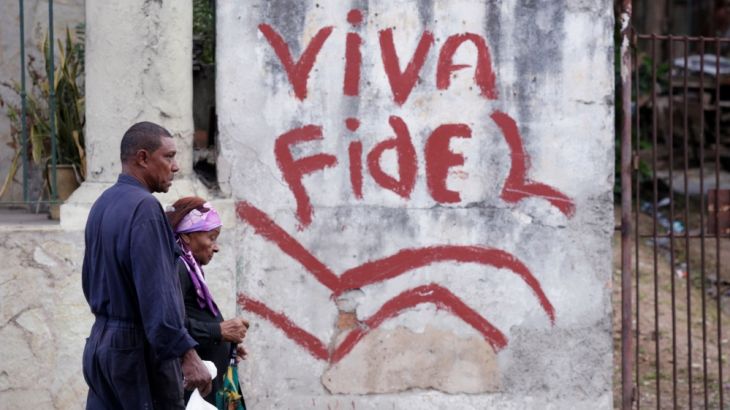Cuba begins nine days of mourning for Fidel Castro
Sadness on Havana’s streets for late leader while in US state of Florida celebrations continue in Miami’s Little Havana.

Cuban students waving flags broke into a mass chant of “I am Fidel” to salute Fidel Castro as nine days of mourning began for the Cold War icon, who dominated the island’s political life for generations.
Alcohol sales were suspended, flags flew at half-staff and shows and concerts were cancelled after his younger brother and successor, President Raul Castro, told the country on Friday that Fidel had died at 10:29pm, without giving a cause of death.
Keep reading
list of 4 itemsWhat’s going wrong in Cuba? | Start Here
Cuba has a new leader and it’s not a Castro
A new era in Cuba?
Giant rallies are planned in Havana’s Revolution Square and in the eastern city of Santiago to honour Castro, who died aged 90, six decades after the brothers set out from Mexico to overthrow the government of Fulgencio Batista.
|
|
Newspapers on the island of 11 million people were printed in black ink to mourn Fidel, instead of the usual red of the official Communist Party daily Granma, and the blue of Juventud Rebelde (Rebel Youth), the paper of the Communist youth.
There was no heightened military or police presence to mark the passing of the epochal revolutionary leader, and at Havana University, Castro’s alma mater, hundreds of students gathered to wave huge Cuban flags and shout “Viva Fidel and Viva Raul”.
Laydis Valdes, a 43-year-old, pulls a gas canister in El Cerro, a residential district of Havana. Her building does not have a gas connection. Like many in Cuba, she has to walk a few blocks and show her ration book to pick up her month’s supply.
“I’m distraught. The news hit me really hard,” she told Al Jazeera on Sunday.
“Fidel fought and struggled for us so much. He’s like a father figure to us. I found out about his death when I turned on the TV yesterday morning. We were so shocked. My husband and I started to cry.
READ MORE: Cuban leader Fidel Castro’s mixed legacy
“We informed the neighbours and then went outside. There was already a small crowd on the streets. there were lots of tears and lots of emotion. My husband started to feel sick. I had to take him to the hospital.”
Life in Havana went on largely as normal, only quieter and more subdued.
Street vendors sold food and handcrafts from stalls to passers-by, while 1950s Chevrolets full of dents and held together by makeshift repairs cruised by, crammed with passengers.
Nevertheless, Saturday was a day for reflection.
|
|
Castro’s remains were cremated, and his ashes will be taken around Cuba until a state funeral on December 4.
Diplomatic officials said foreign dignitaries will arrive by Tuesday for a memorial service to be held in Revolution Square that evening.
Ninety-year-old Chile Rosas is of a mixed race. He will not be going to any of the official events to mourn El Caballo.
“Fidel was a great orator, and he knew how to play with the psychology of crowds,” he said.
“I never went to the Plaza de la Revolucion when he spoke. I’m not particularly sad about his passing. We all have it coming.
“At the end of the day, what’s going to change,” he added while gesturing to the overflowing bins and the long queue where his neighbours wait under the Caribbean sun.
“Tomorrow, there will still be potholes in the streets and queues for bread.”
There will be no top-level games of baseball – Castro’s passion after politics – for the nine-day period of mourning, the sport’s national federation declared.
Cuban state television, student associations and the women’s federation had organised smaller rallies to mourn Fidel Castro and pledge their support to the revolution.
![Cuban Americans celebrate Castro's passing in Miami's Little Havana district [Javier Galeano/Reuters]](/wp-content/uploads/2016/11/65e1d77f6e5846739b913b8761bcda80_18.jpeg)
In Florida, on the other hand, Fidel Castro’s death has prompted an emotional and long-awaited celebration among the city’s Cuban-American community.
Peaceful demonstrators waved flags and honked car horns, many cheering with joy and others weeping for family members who did not live to see this day.
Shortly after Castro’s death was announced on Saturday, thousands poured into the streets of Miami’s Little Havana, banging pots with spoons, waving Cuban flags and setting off fireworks.
They see Fidel Castro’s death as a sign that a generation that has ruled Cuba for nearly 60 years is passing from the world stage.
But others caution that much work remains to enact change in Cuba.
Sensing the historic moment, younger revellers streamed the event on Facebook Live, posted pictures on Instagram, and broadcast the celebrations on FaceTime and Skype to friends and relatives on the island.
Little Havana and Hialeah – areas where many Cuban exiles settled – saw people dance, hug, and exchange comments like “It took so long,” and “Now it’s Raul’s turn”.
“Cuba Libre” – Free Cuba – has been a rallying cry for exiles ever since the Castro brothers took over Cuba in 1959. The rum and Coke drink of the same name, however, predates the Castro era.
About two million Cubans live in the United States, nearly 70 percent of them in Florida.